
Rabbit Anti-HSP90 alpha antibody
HSP-90 alpha; HSP 86; HSP 86; Renal carcinoma antigen NY REN 38; Heat shock 86 kDa; Heat shock 90kDa protein 1 alpha; Heat shock protein 90kDa alpha (cytosolic) class A member 1; heat shock protein 90kDa alpha (cytosolic), class A member 2; Heat shock pro
View History [Clear]
Details
Product Name [KO validated anti] HSP90 alpha Chinese Name 热休克蛋白90α抗体 Alias HSP-90 alpha; HSP 86; HSP 86; Renal carcinoma antigen NY REN 38; Heat shock 86 kDa; Heat shock 90kDa protein 1 alpha; Heat shock protein 90kDa alpha (cytosolic) class A member 1; heat shock protein 90kDa alpha (cytosolic), class A member 2; Heat shock protein HSP 90-alpha; HS90A_HUMAN; HSP 86; HSP86; Hsp89; HSP89A; HSP90A; HSP90AA1; HSP90ALPHA; HSP90N; HSPC1; HSPCA; HSPCAL1; HSPCAL3; HSPCAL4; HSPN; LAP2; Renal carcinoma antigen NY-REN-38. literatures Immunogen Species Rabbit Clonality Polyclonal React Species Human, Mouse, (predicted: Rat, Chicken, Dog, Pig, Cow, Horse, Rabbit, Sheep, ) Applications WB=1:500-2000 ELISA=1:5000-10000 IHC-P=1:100-500 IHC-F=1:100-500 ICC=1:100 IF=1:100-500 (Paraffin sections need antigen repair)
not yet tested in other applications.
optimal dilutions/concentrations should be determined by the end user.Theoretical molecular weight 81kDa Cellular localization cytoplasmic The cell membrane Form Liquid Concentration 1mg/ml immunogen KLH conjugated synthetic peptide derived from human HSP90 alpha: 401-500/732 Lsotype IgG Purification affinity purified by Protein A Buffer Solution 0.01M TBS(pH7.4) with 1% BSA, 0.03% Proclin300 and 50% Glycerol. Storage Shipped at 4℃. Store at -20 °C for one year. Avoid repeated freeze/thaw cycles. Attention This product as supplied is intended for research use only, not for use in human, therapeutic or diagnostic applications. PubMed PubMed Product Detail Hsp90 (heat shock protein 90) is a molecular chaperone and is one of the most abundant proteins in unstressed cells. It is an ubiquitous molecular chaperone found in eubacteria and all branches of eukarya, but it is apparently absent in archaea. Whereas cytoplasmic Hsp90 is essential for viability under all conditions in eukaryotes, the bacterial homologue HtpG is dispensable under non-heat stress conditions.
Function:
Molecular chaperone that promotes the maturation, structural maintenance and proper regulation of specific target proteins involved for instance in cell cycle control and signal transduction. Undergoes a functional cycle that is linked to its ATPase activity. This cycle probably induces conformational changes in the client proteins, thereby causing their activation. Interacts dynamically with various co-chaperones that modulate its substrate recognition, ATPase cycle and chaperone function.
Subunit:
Homodimer. Interacts with AHSA1, FNIP1, HSF1, SMYD3 and TOM34. Interacts with TERT; the interaction, together with PTGES3, is required for correct assembly and stabilization of the TERT holoenzyme complex. Interacts with CHORDC1 and DNAJC7. Interacts with STUB1 and UBE2N; may couple the chaperone and ubiquitination systems.
Subcellular Location:
Cytoplasm. Melanosome. Note=Identified by mass spectrometry in melanosome fractions from stage I to stage IV.
Post-translational modifications:
ISGylated.
S-nitrosylated; negatively regulates the ATPase activity and the activation of eNOS by HSP90AA1.
Similarity:
Belongs to the heat shock protein 90 family.
SWISS:
P07900
Gene ID:
3320
Database links:Entrez Gene: 3320 Human
Entrez Gene: 15519 Mouse
Omim: 140571 Human
SwissProt: P07900 Human
SwissProt: P07901 Mouse
Unigene: 525600 Human
Unigene: 700831 Human
Unigene: 1843 Mouse
Unigene: 341186 Mouse
Unigene: 119867 Rat
Product Picture
Lane 1: Mouse Testis tissue lysates
Lane 2: Mouse Placenta tissue lysates
Lane 3: Human U251 cell lysates
Lane 4: Human Molt-4 cell lysates
Primary: Anti-HSP90 alpha (SL10100R) at 1/1000 dilution
Secondary: IRDye800CW Goat Anti-Rabbit IgG at 1/20000 dilution
Predicted band size: 81 kD
Observed band size: 90 kD
Sample:
Testis (Mouse) Lysate at 40 ug
Primary: Anti-HSP90 alpha (SL10100R) at 1/500 dilution
Secondary: IRDye800CW Goat Anti-Rabbit IgG at 1/20000 dilution
Predicted band size: 81 kD
Observed band size: 98 kD
Sample:
293T(Human) Cell Lysate at 30 ug
293T KO HSP90 alpha (Human) Cell Lysate at 30 ug
Primary: Anti- HSP90 alpha (SL10100R) at 1/1000 dilution
Secondary: IRDye800CW Goat Anti-Rabbit IgG at 1/20000 dilution
Predicted band size: 81 kD
Observed band size: 77 kD
Paraformaldehyde-fixed, paraffin embedded (mouse testis tissue); Antigen retrieval by boiling in sodium citrate buffer (pH6.0) for 15min; Block endogenous peroxidase by 3% hydrogen peroxide for 20 minutes; Blocking buffer (normal goat serum) at 37°C for 30min; Antibody incubation with (HSP90 alpha) Polyclonal Antibody, Unconjugated (SL10100R) at 1:400 overnight at 4°C, followed by operating according to SP Kit(Rabbit) (sp-0023) instructionsand DAB staining.Hela cell; 4% Paraformaldehyde-fixed; Triton X-100 at room temperature for 20 min; Blocking buffer (normal goat serum, C-0005) at 37°C for 20 min; Antibody incubation with (HSP90 alpha) polyclonal Antibody, Unconjugated (SL10100R) 1:100, 90 minutes at 37°C; followed by a conjugated Goat Anti-Rabbit IgG antibody at 37°C for 90 minutes, DAPI (blue, C02-04002) was used to stain the cell nuclei.
References (0)
No References
Bought notes(bought amounts latest0)
No one bought this product
User Comment(Total0User Comment Num)
- No comment
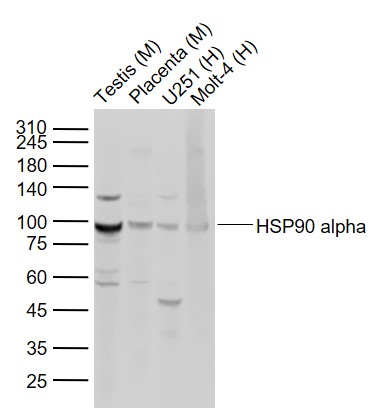
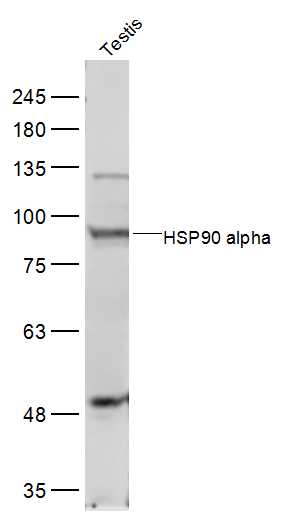
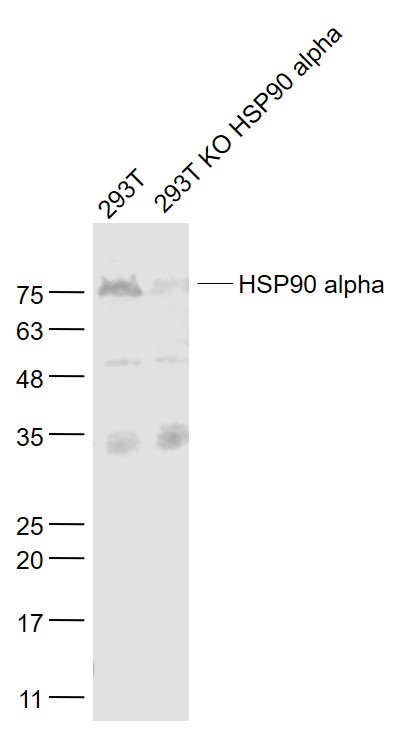
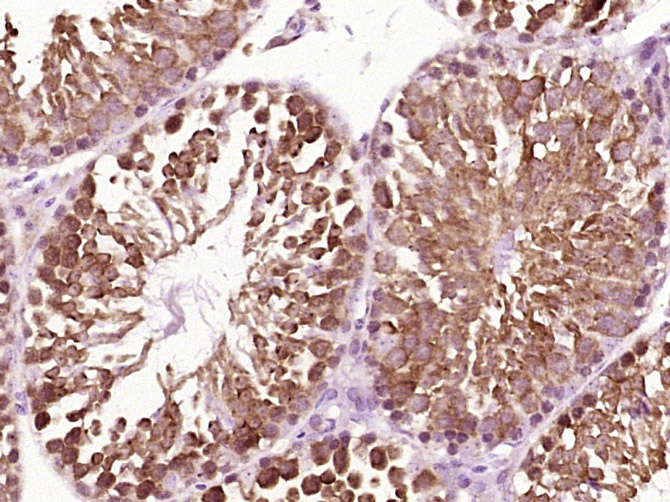
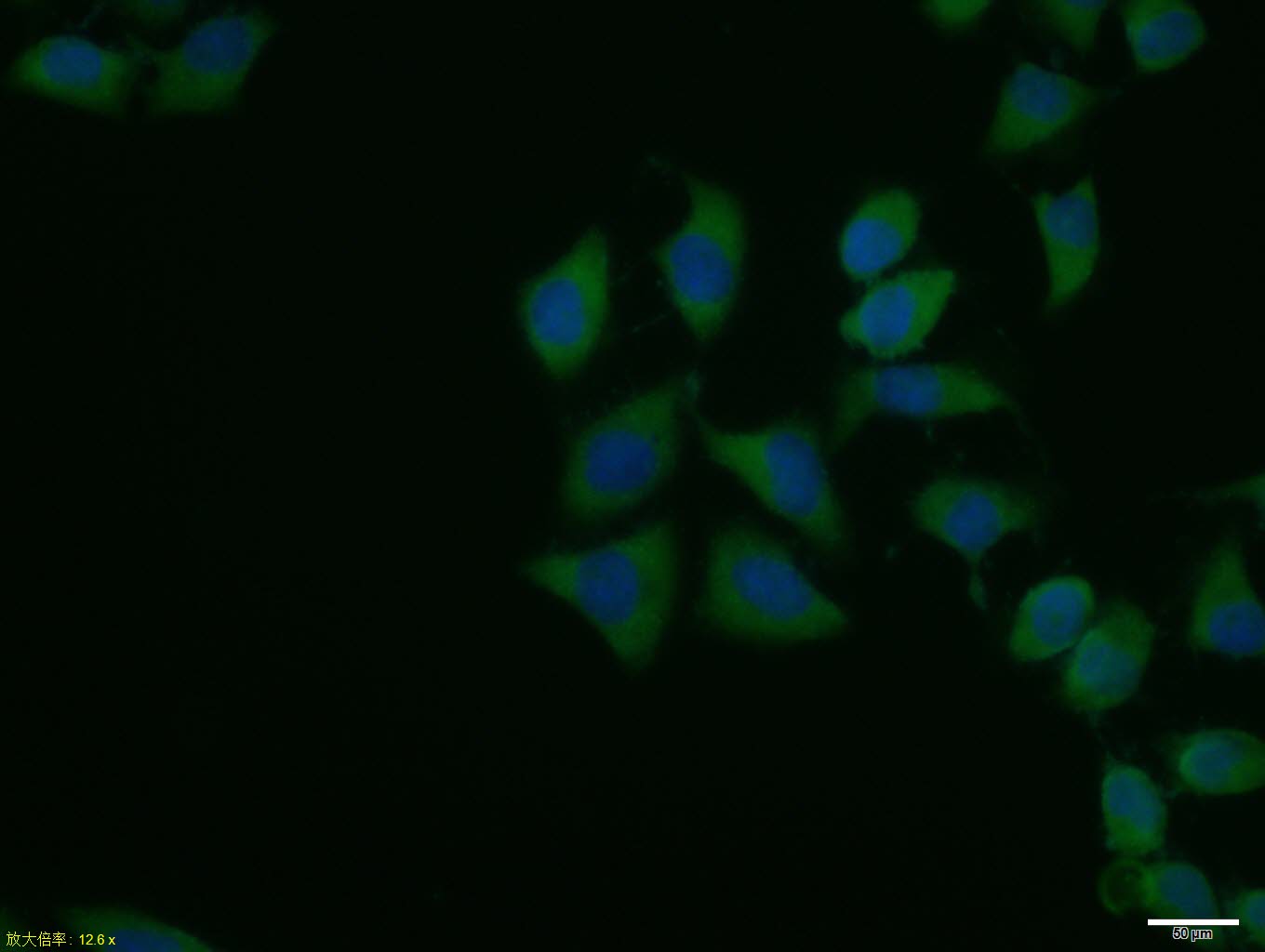


 +86 571 56623320
+86 571 56623320
 +86 18668110335
+86 18668110335

